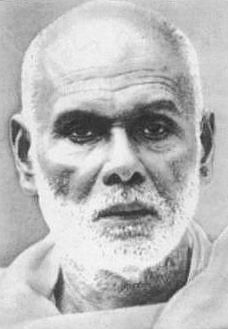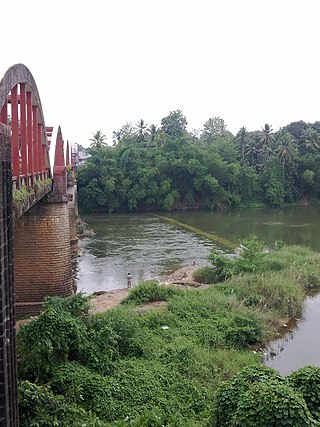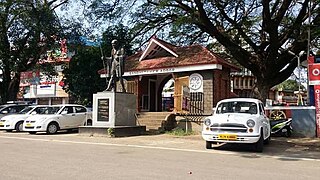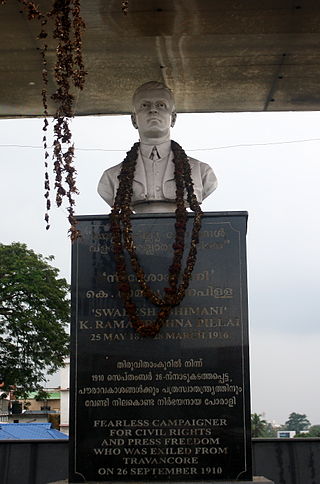
Pathanamthitta District, is one of the 14 districts in the Indian state of Kerala. The district headquarters is in the town of Pathanamthitta. There are four municipalities in Pathanamthitta: Adoor, Pandalam, Pathanamthitta and Thiruvalla.

Koyapalli Kelappan was an Indian politician, independence activist, educationist and journalist. During the Indian independence movement, he was the lead figure of Indian National Congress in Kerala and was popularly known as Kerala Gandhi. After Indian independence, he held various seats in Gandhian organisations. He was the co-founder and the first president of the Nair Service Society and was also the founder of Kerala Kshetra Samrakshana Samiti.

The Temple Entry Proclamation was issued by Maharaja Chithira Thirunal Balarama Varma on November 12, 1936. The Proclamation abolished the ban on the backward and marginalised communities, from entering Hindu temples in the Princely State of Travancore, now part of Kerala, India.

Kozhencherry is a census town in Pathanamthitta district of Central Travancore region in Kerala state, India. As of 2011 census, the population was 12,021 of which 5,594 are males while 6,427 are females.

Aranmula is a temple town in the state of Kerala, India. It is known as the cultural capital of Pathanamthitta district, located at a distance of around 116 km from Trivandrum, the capital of Kerala, it is situated on the banks of the river Pampa. A centre of pilgrimage from time immemorial and a trade post of eminence, when the river was the chief means of transport, it is near Kozhencherry in Pathanamthitta District. It is easily accessible from Chengannur railway station (10km). It is one of the Fastest Growing Village. Aranmula, along with the majority of Pathanamthitta district, was part of the Quilon division or Central Travancore division of Travancore. On November 1, 1982, Pathanamthitta district was established.

Adoor is a municipality in the Pathanamthitta district of Kerala, India. It is the headquarters of the Adoor Taluk and Adoor Revenue Division. Adoor is located 18 km (11.2 mi) southwest of the district headquarters Pathanamthitta and 85 km (52.8 mi) north of the state capital Thiruvananthapuram.

Chengannur is a municipality in the Alappuzha district of Kerala, India. It is located 43 km (26.7 mi) south east of the district headquarters in Alappuzha and about 98 km (60.9 mi) north of the state capital Thiruvananthapuram. As per the 2011 Indian census, Chengannur has a population of 23,466 people, and a population density of 1,607/km2 (4,160/sq mi).

Kottarakkara, also transliterated as Kottarakara, is a town and municipality in the Kollam district of the Kerala, India. Kottarakkara lies 27 kilometres (17 mi) to the east of Kollam city centre.

Ranni or Ranny is a town in the Pathanamthitta district of Kerala, India, and the 16th largest taluk in Kerala, located on both sides of the Pamba River.It Comes Under Thiruvalla Revenue Division.It Is located 27 km from Thiruvalla railway station & NH 183 in Thiruvalla.

Pathanamthitta, is a municipality situated in the Southern Kerala, India, spread over an area of 23.50 km2. It is the administrative capital of Pathanamthitta district. The town has a population of 37,538. The Hindu pilgrim centre Sabarimala is situated in the Pathanamthitta district; as the main transport hub to Sabarimala, the town is known as the 'Pilgrim Capital of Kerala'. Pathanamthitta District, the thirteenth revenue district of the State of Kerala, was formed with effect from 1 November 1982, with headquarters at Pathanamthitta. Forest covers more than half of the total area of the District. Pathanamthitta District ranks the 7th in area in the State. The district has its borders with Allepey, Kottayam, Kollam and Idukki districts of Kerala and Tamil Nadu. Nearest town is Thiruvalla, located at a distance of 30 km. Thiruvalla railway station is 30 km via Thiruvalla-Kumbazha highway.

Poonjar is a small Indian town located on the eastern side of Kottayam district in Kerala state, India. Before the independence of India, Poonjar had been the part of Travancore princely state. Erattupetta, Teekoy, Bharananganam, and Vagamon are the nearest towns and villages of Poonjar. Taluk Headquarters, Pala is 18 kilometres away from Poonjar, Kanjirapally is 22.6 kilometres away from Poonjar and Thodupuzha is 34 kilometeres away from Poonjar.

Elavumthitta is a town in Pathanamthitta district of Kerala, India. The majority of its inhabitants are from Hindu and Christian backgrounds. The primary crops are rubber, coconut, black pepper and plantain. The terrain is hilly with plenty of paddy fields in between. It is the commercial centre of Mezhuveli and Chenneerkara panchayaths.
G. Ramachandhran was a soldier for the Gandhian cause, social reformer and a teacher. With his wife, Dr. T. S. Soundram, daughter of T V Sundaram Iyengar, founder of TVS Group, he started the Gandhigram, Tamil Nadu in 1945. He authored several books. Viswabharati, Rabindranath Tagore's University, in Santhiniketan awarded him the higher title "Desikottama".

K. Ramakrishna Pillai (1878–1916) was an Indian nationalist writer, journalist, editor, and political activist. He edited Swadeshabhimani, the newspaper which became a potent weapon against the rule of the British and the erstwhile princely state of Travancore and a tool for social transformation. His criticism of the Diwan of Travancore, P. Rajagopalachari and the Maharajah led to the eventual confiscation of the newspaper. Ramakrishna Pillai was arrested and exiled from Travancore in 1910. Vrithantha Pathra Pravarthanam (1912) and Karl Marx (1912) are among his most noted works in Malayalam, Vrithantha Pathra pravarthanam being the first book on journalism in Malayalam and Karl Marx, the first ever biography of Karl Marx in any Indian language. But it has been alleged that he plagiarized the biography from an essay, "Karl Marx: A Modern Rishi", by Lala Hardayal, published in 1912 March issue of the Modern Review, published from Kolkata.
Swadeshabhimani was a newspaper published in the Kingdom of Travancore, which was banned and confiscated by the Government of Travancore in 1910 due to its criticisms against the government and the Diwan of Travancore, P. Rajagopalachari.

Vaikom Satyagraha, from 30 March 1924 to 23 November 1925, was a nonviolent agitation for access to the prohibited public environs of the Vaikom Temple in the Kingdom of Travancore. Kingdom of Travancore was known for its rigid and oppressive caste system. The campaign was conduct and led by Congress, leadersT. K. Madhavan, K. Kelappan, K. P. Kesava Menon. Other notable leaders who participated in the campaign include George Joseph, E. V. Ramasamy "Periyar" and it was noted for the active support and participation offered by different communities and a variety of activists.
St. Thomas Higher Secondary School, Kozhencherry is a school in Kerala, the southwestern state of India. It is located in the town centre, on the way from Kozhencherry to the district capital Pathanamthitta.

Kannur, formerly known in English as Cannanore, Arabic as Kannanur, and Portuguese as Cananor, is a city and a Municipal Corporation in North Malabar region, state of Kerala, India. It is the largest city in North Malabar, which is the northernmost region of Kerala. It is sometimes identified Kolathunadu, which was ruled by the Kolathiris. In the 12th and 13th centuries there was trade with Persia and Arabia.

K. Kumar (1894–1973) was an Indian orator, reformer and writer of the Indian pre-independence era. He was one of the earliest socio-political leaders to have brought Mahatma Gandhi's message and the spirit of the national movement to the erstwhile Travancore State.
![shrii bhgvtikunnu ksseetrtti[?]rre kettttukaalllc.jpg](http://upload.wikimedia.org/wikipedia/commons/thumb/c/cd/%E0%B4%B6%E0%B5%8D%E0%B4%B0%E0%B5%80_%E0%B4%AD%E0%B4%97%E0%B4%B5%E0%B4%A4%E0%B4%BF%E0%B4%95%E0%B5%81%E0%B4%A8%E0%B5%8D%E0%B4%A8%E0%B5%81_%E0%B4%95%E0%B5%8D%E0%B4%B7%E0%B5%87%E0%B4%A4%E0%B5%8D%E0%B4%B0%E0%B4%A4%E0%B5%8D%E0%B4%A4%E0%B4%BF%E0%B5%BB%E0%B4%B1%E0%B5%86_%E0%B4%95%E0%B5%86%E0%B4%9F%E0%B5%8D%E0%B4%9F%E0%B5%81%E0%B4%95%E0%B4%BE%E0%B4%B4%E0%B5%8D%E0%B4%9A.jpg/250px-%E0%B4%B6%E0%B5%8D%E0%B4%B0%E0%B5%80_%E0%B4%AD%E0%B4%97%E0%B4%B5%E0%B4%A4%E0%B4%BF%E0%B4%95%E0%B5%81%E0%B4%A8%E0%B5%8D%E0%B4%A8%E0%B5%81_%E0%B4%95%E0%B5%8D%E0%B4%B7%E0%B5%87%E0%B4%A4%E0%B5%8D%E0%B4%B0%E0%B4%A4%E0%B5%8D%E0%B4%A4%E0%B4%BF%E0%B5%BB%E0%B4%B1%E0%B5%86_%E0%B4%95%E0%B5%86%E0%B4%9F%E0%B5%8D%E0%B4%9F%E0%B5%81%E0%B4%95%E0%B4%BE%E0%B4%B4%E0%B5%8D%E0%B4%9A.jpg)
















